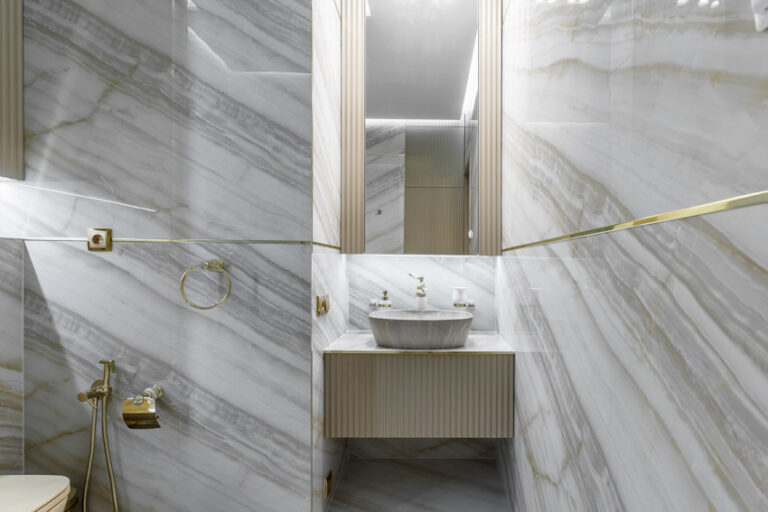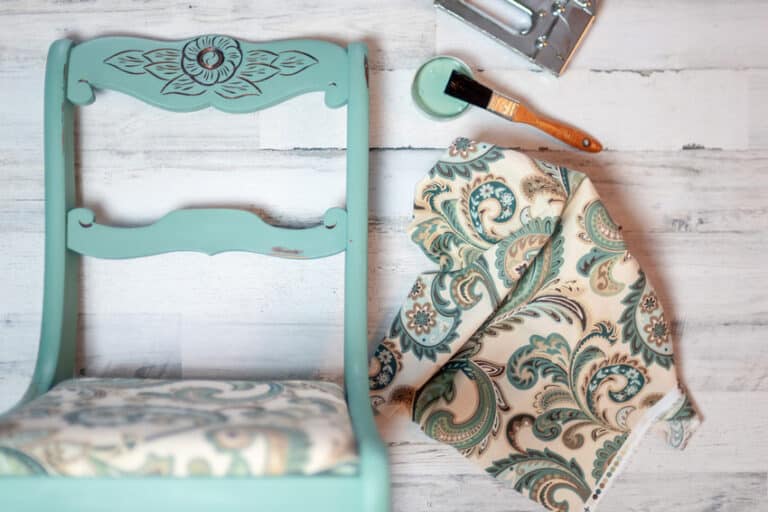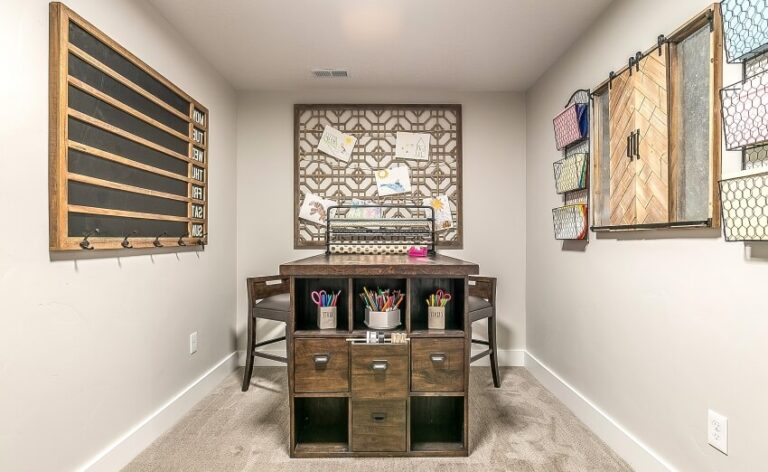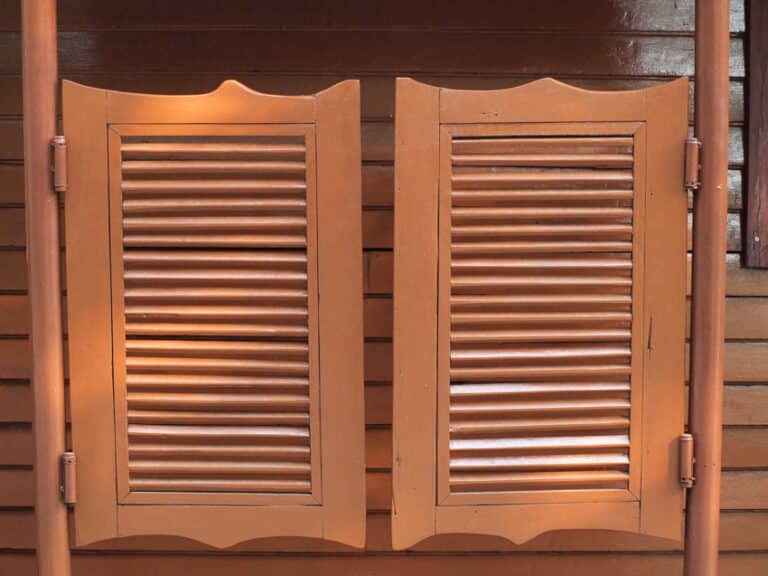Types Of Terrazzo Flooring (Systems & Options)
Find out the different types of terrazzo flooring including their pros and cons, design styles, cost, tips cleaning & polishing tips, and a comparison of terrazzo vs granite floors.

Terrazzo is one of the most eco-friendly flooring options on the marketplace today since it is a composite material, and it comes in a variety of styles based on the materials and processes utilized.
We will go over the most popular terrazzo flooring systems commercially available. But first, let us define what terrazzo flooring is.
What Is Terrazzo?

Terrazzo is a flooring material that can be formed into a variety of distinctive finishes. To simplify this construction material, terrazzo is defined as a composite material that is put in position or prepared for precast terrazzo.
Terrazzo is utilized not only for floors but also for bases, walls, stair treads, worktops, and other customized applications.
Terrazzo is made up of pieces of granite, marble, quartz, crystal, shell, or other equivalent materials. The adhesive is either cement or an epoxy substrate.
The procedure of creating terrazzo flooring is pretty impressive. Granite, marble, or even quartz pieces are laid on a substrate of wet concrete and allowed to settle. The top is then polished to make it seamless.
Terrazzo Systems
Terrazzo is classified into several flooring systems. Here are their names and descriptions:
Epoxy Terrazzo
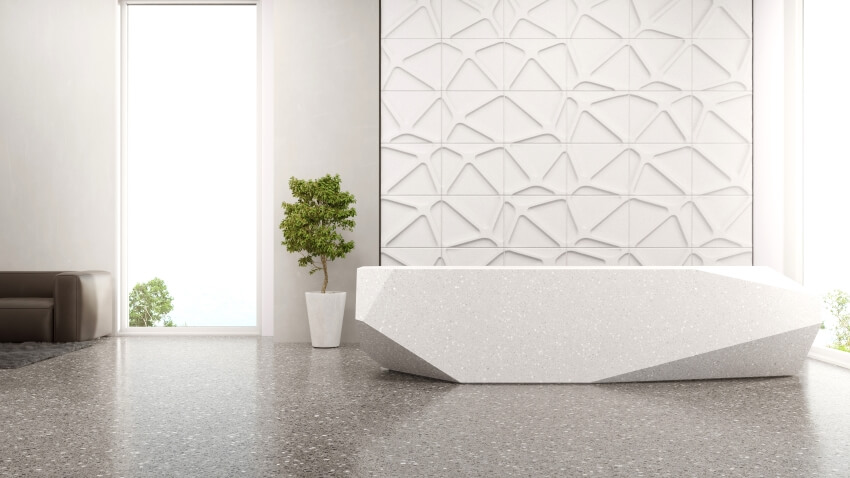
Nowadays, epoxy terrazzo is the most frequently implemented technique in commercial structures. Over 90% of terrazzo projects in the United States are epoxy-based.
Epoxy resin is commonly used, though polyacrylate is also a frequent replacement. The matrix in thin-set epoxy terrazzo systems can either be epoxy resin or polyacrylate.
Polyacrylate is a cement-customized acrylate that has greater tensile strength and shock resistance than cement. Polyacrylate also permits vapor transmission.
A 1/4-inch or 3/8-inch thick resinous overlay is placed directly over the cement floor in this non-cement-based technique. The terrazzo is thin and light, as the name and features suggest, yet incredibly resilient and sturdy.
This terrazzo system consists of only two layers: a cement flooring and a resin covering, with a permeable barrier in between to prevent small cracks.
Dividers made of brass, zinc, or plastic should be set above any control seams (gaping holes in the slab that enable the concrete to contract or expand as temperatures fluctuate) in the subfloor to prevent the terrazzo finish from cracking along the seams.
Thin-set epoxy terrazzo has excellent compressive and tensile qualities, which provide benefits such as slip resistance and chemical protection. This terrazzo type is a great selection for both residential and commercial spaces since it is available in a plethora of shapes and patterns.
Furthermore, the design customization versatility of epoxy terrazzo is practically endless in terms of color combinations and various materials that can be incorporated. One downside of epoxy terrazzo is that it is not recommended for outside use because it cannot endure extreme weather conditions.
However, it is best suited for indoor counters and flooring. Check out our epoxy floor design guide for more information about epoxy.
Cement Terrazzo
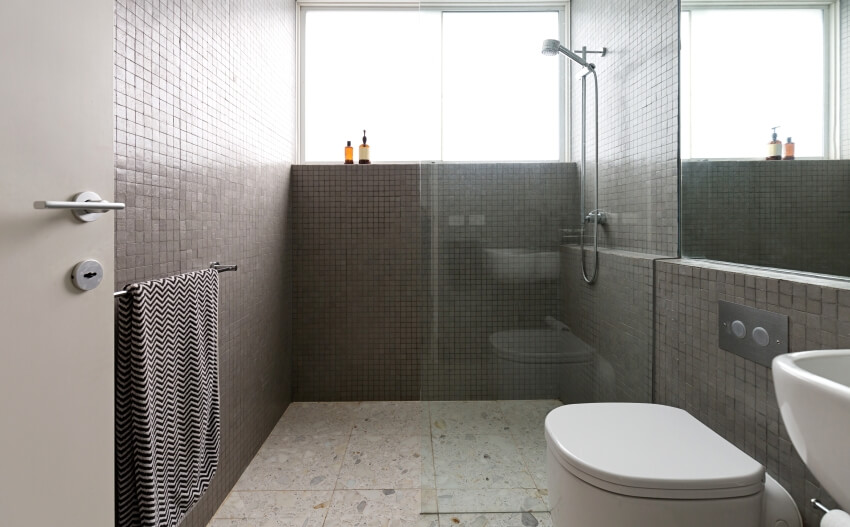
Weather conditions must be adequate during cementitious terrazzo construction to assure that no fractures emerge as a result. Extreme caution must also be applied when mixing and putting out cement terrazzo to guarantee that the installation lasts for at least 60 years.
Other cement terrazzo is far better suited to more problematic locations, outside uses, and remodeling operations where there is no functioning vapor barrier underneath the substrate.
This technique is frequently denser and heavier than epoxy options due to the use of a cement-based mixture with included aggregates. Because of its thick, sturdy character, it is more resistant to shocks, steam cleaning, point loading, and heavy traffic.
Because curing might take up to 7 days before proceeding to polish, the application zone must be kept clear of traffic until that time. For businesses, this can entail disruption and a loss of regular income as a result of the closure.
Even though there are fewer color selections for cement terrazzo than for epoxy systems, stunning earthy tones can be achieved with this selection. For more related ideas see our article about concrete floor finishes.
Bonded Terrazzo
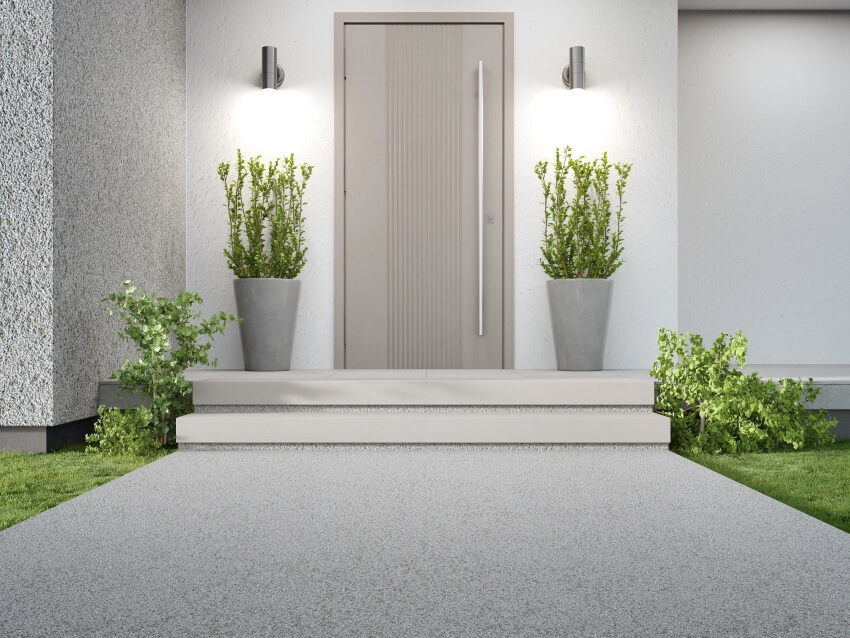
The slab and terrazzo topper are ‘bonded,’ as the term implies, with the use of sand-cement mortar coating that is typically 1.75 to 2.25 inches thick.
Since the mortar readily adapts to the differences or texture of the concrete slab, the slab’s quality is not as crucial. The terrazzo topper is 0.5 inches thick, comparable to a sand cushion.
Sand Cushion Terrazzo
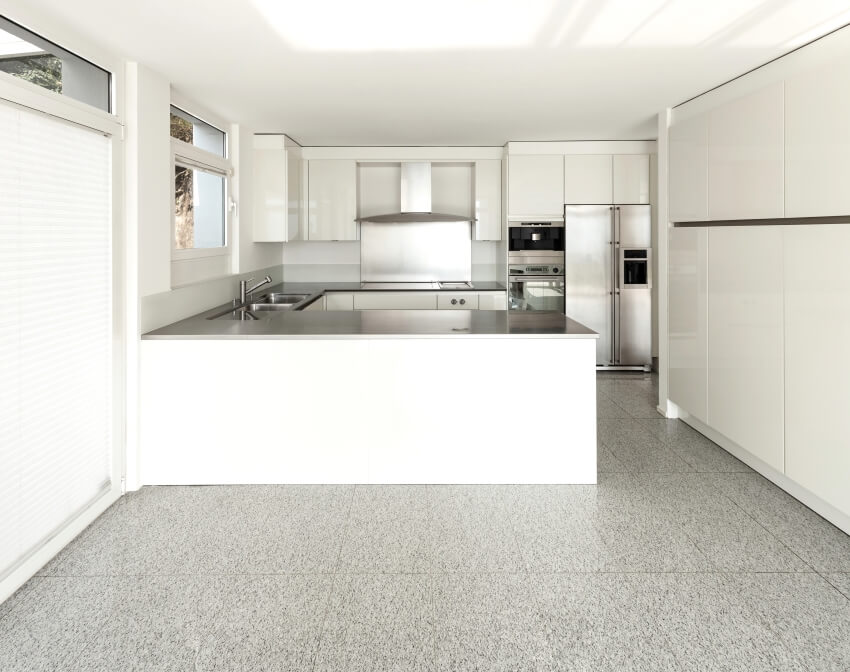
The said mesh supports the terrazzo topping’s ‘underbed,’ which itself is constructed of cement and sand. Between the upper layer (the terrazzo top) and the underbed, vertically positioned divider strips are installed at frequent intervals.
The goal of these strips is to avoid predicted contraction and to improve the beauty of the terrazzo’s colors and patterning. Furthermore, this is to allow for slight flaws while eliminating surface mirroring, making it ideal for integrating designs such as trademarks and works of art with many colors.
Sand-cushion terrazzo flooring cushions subtle irregularities and prevents them from reflecting the surface, making it the best choice for rooms with a lot of activity and contact. The overall design will necessitate a 2.5 to 3-inch slab slump over which the 0.5-inch terrazzo topping will be installed.
Rustic Terrazzo
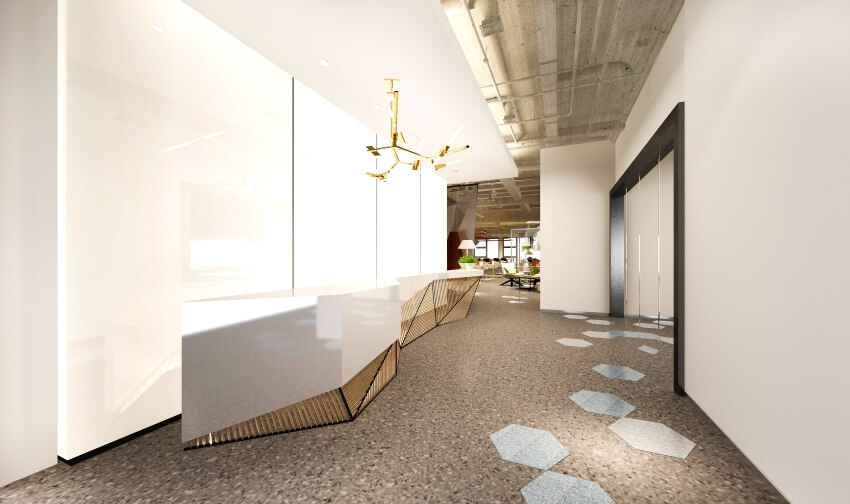
Aside from that, rustic terrazzo offers a wide range of uses, but it necessitates a 2-inch slab hollow for installation. Rustic or faded terrazzo is made out of a non-ground, rough cement matrix topping, which can be paired with bonded or monolithic variants.
It is similar to epoxy terrazzo, but it is more suited for outdoor applications due to its unique marble-like surface with a textured surface incorporated to boost slide resistance.
Outdoor spaces of hotels, malls, museums, townhouses, and most industrial establishments with water attractions such as fountains and man-made waterfalls are more likely to have rustic terrazzo.
Monolithic Terrazzo
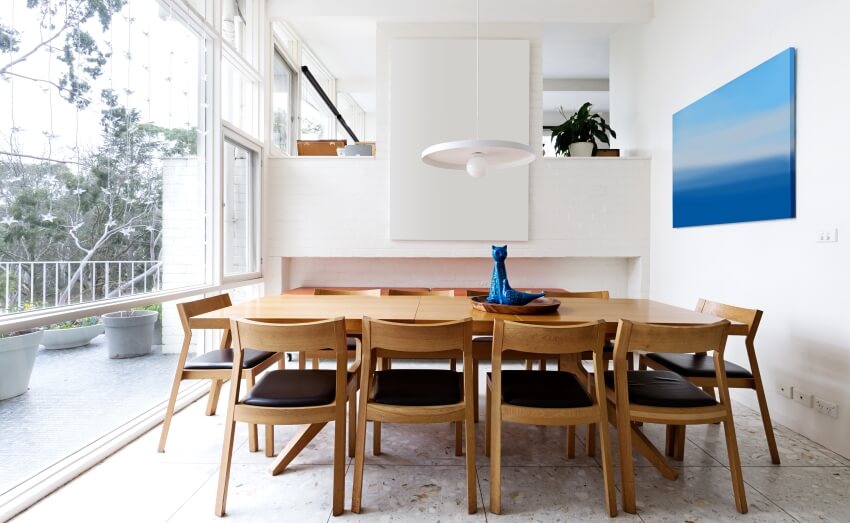
The terrazzo should be 5/8 of an inch thick. Monolithic terrazzo is a low-cost variant of terrazzo that was designed to provide architects with decent-quality terrazzo flooring.
In addition, monolithic terrazzo is a long-lasting and low-cost terrazzo system that is noted for its rapid installation. Unlike bonded terrazzo, this type is dependent on the quality and uniformity of the concrete slab.
This is because a monolithic terrazzo structure consists of a 0.5-inch-thick terrazzo topper laid straight over the concrete floor.
However, a bonding solution is necessary between the two layers of this formulation so that the top terrazzo layer sticks to the concrete and secures the system.
Polyacrylate Terrazzo
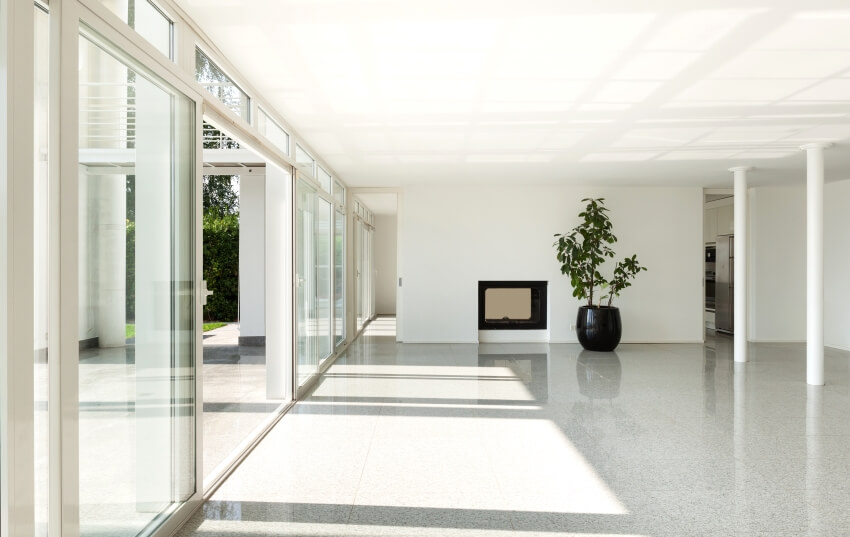
Polyacrylate terrazzo has various benefits over traditional terrazzo. The pieces are not simply set in dense cement.
However, they are deposited in a matrix, or mixture, of concrete and latex. Because the latex supports the concrete, the terrazzo coating can be applied as sparsely as 3/8 of an inch. Rather than hovering on a sand cushion over the cement subfloor, it is attached directly to the concrete sublayer underneath.
Polyacrylate terrazzo systems dry faster than regular terrazzo and may typically be placed in one day, thanks to the feature that they are usually connected to a pre-existing concrete slab.
Moreover, polyacrylate terrazzo flooring is less costly since they necessitate less labor and fewer materials due to their rapid cure. If you want to install terrazzo in your home, it can be a smart idea if you currently have a flat slab.
Because polyacrylate terrazzo is permeable, it can also be put outdoors. In addition, unlike cement terrazzo, certain polyacrylate terrazzo compositions permit you to utilize glass and mirror shards, such as repurposed glass. The aggregate can also come in a variety of sizes.
Polyacrylate may be colored to match almost any shade, and it even comes in more vivid colors than traditional cement terrazzo. Because it is so thin and cures swiftly, it is frequently used on walls as well as other applications.
Terrazzo Pros And Cons
Here are the advantages and disadvantages of terrazzo flooring starting with the benefits.
Pros of Terrazzo
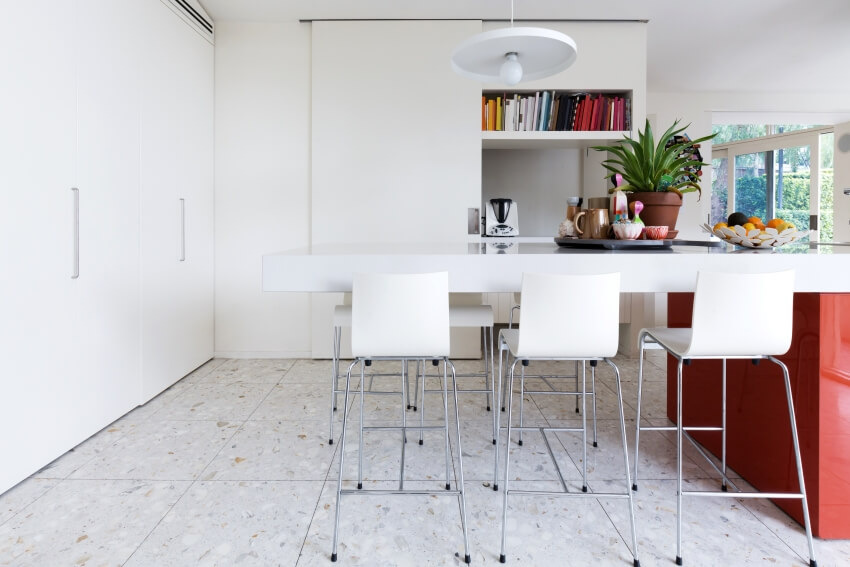
It also does not deteriorate like some other materials. Architects are turning to terrazzo as the material’s reputation and popularity continue to grow.
Moreover, terrazzo floors can handle high-traffic locations, making them a popular choice for commercial structures. Even if terrazzo has deteriorated over time, it may be refurbished and shined to appear as fresh as before. Terrazzo delivers long-lasting flooring at a cheap price. Plus, it is very easy to maintain.
Available in a Wide Range of Design Options – Terrazzo normally integrates granite, marble, quartz, or glass pieces in an epoxy resin matrix, preserving the aesthetic character of classic terrazzo.
Since terrazzo is made by combining several components, you can select practically any style of flooring for any project. This enables architects to incorporate abstract ornamental motifs, seals, emblems, and other patterns into terrazzo installations.
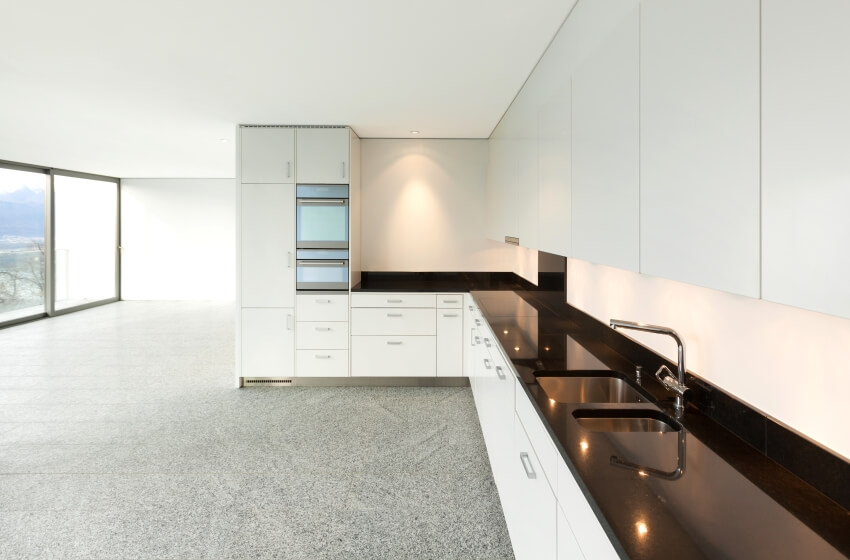
The material could be made of repurposed materials that are good for everyone’s health and the ecosystem as well. Terrazzo has the potential to shape the world of architecture since it is innovative, made from recyclable resources, and can be supplied locally.
Suitable for Both Indoor And Outdoor Uses – Terrazzo can be installed both indoors and outdoors by terrazzo contractors. Nowadays, this flooring material can be seen in high-traffic locations such as entrances, corridors, and stairwells.
Additionally, terrazzo is an excellent material for countertops, bathtubs, baths, and pools due to its capability to repel wetness and staining. Therefore, whether you opt for thin-set epoxy for interior purposes or rustic terrazzo for exterior purposes, terrazzo can suit the architect’s objectives while also complementing their style.
However, keep in mind that epoxy terrazzo is only suitable for indoor use. For exterior applications, you can pick cement terrazzo.
Cons of Terrazzo
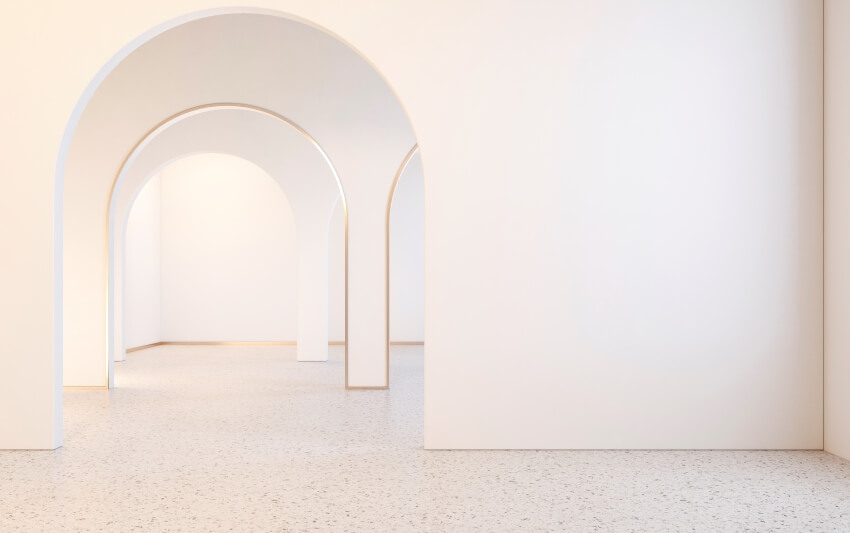
Floor Gets Cold Quickly During Cold Weather – One drawback of terrazzo is that it does not hold warmth effectively during the wintertime, making the flooring feel a bit cold. This may induce unpleasantness to people who walk around the floor barefoot unless there is a heat absorber underneath the terrazzo.
Terrazzo Cost
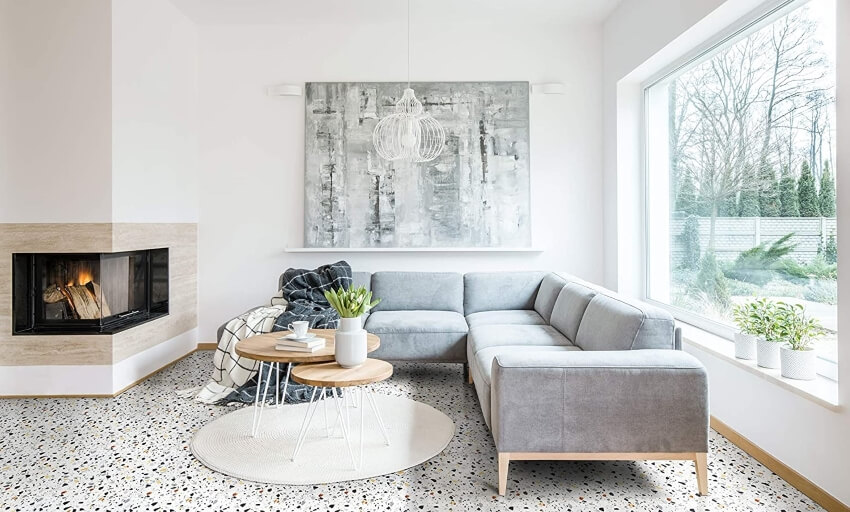
The chips or aggregates employed in this type of flooring have a significant impact on the price of terrazzo flooring. Glass or pottery pieces can be cheap, but massive pieces of marble and mother of pearl are quite costly.
Normally, the cost of regular concrete-based terrazzo flooring tiles typically ranges from roughly $8 per square foot to more than $30 per square foot for flooring with metal or decorative accents.
Epoxy terrazzo can cost around $25 to $28. Sand cushion normally costs around $31, while monolithic terrazzo costs around $23 to $25.
In terms of installation, expect to spend roughly $7 per square foot. Terrazzo floors prepared and built on-site can cost up to $20 per square foot. Although this is a broad range, prices can vary greatly from one area to the next.
That includes only the labor, while the cost of supplies can range from $30 to $80 per square foot. The average cost of flooring installation will range between $20 to $60 for materials and labor.
Is Granite More Expensive Than Terrazzo?
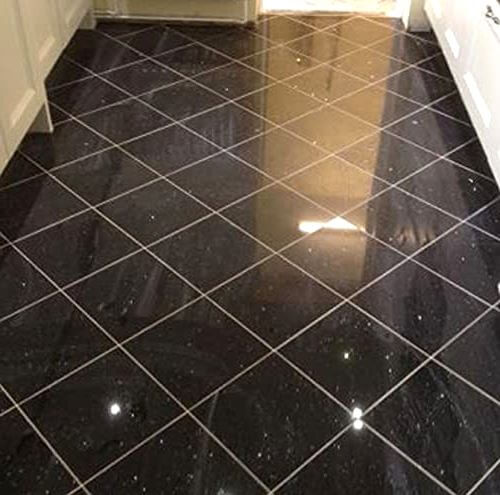
Granite tile costs around $2.50 to $5.00 per square foot. More high-end models and special requests, on the other hand, can cost nearly $6 to $15 or more per square foot.
Yes, certain granite flooring models are more expensive than other terrazzo flooring options. Conversely, certain terrazzo flooring models are more expensive than some granite flooring options.
So, technically, the answer to this question depends on the model and manufacturer of each flooring type. But, if we are going to sum it up, the majority of terrazzo floors are more costly than granite tiles. See our types of floor tiles guide here for more on tile options.
How Long Does Terrazzo Last?
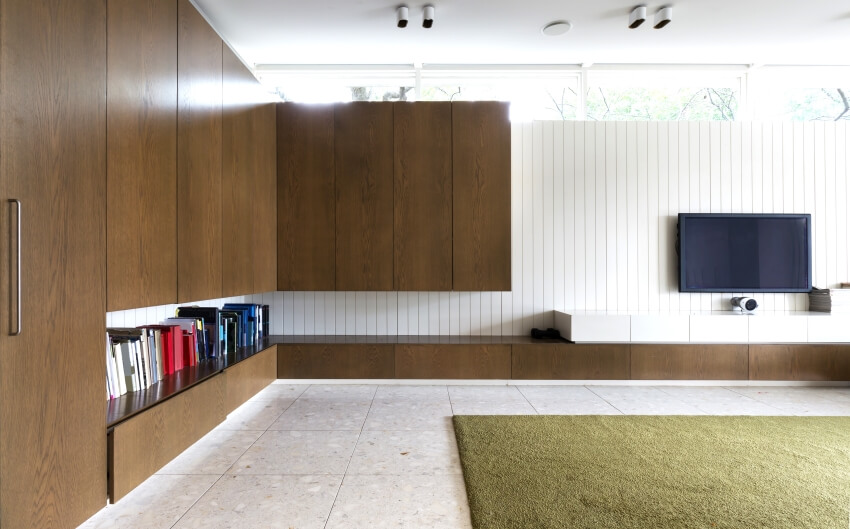
Terrazzo has strong shock absorption and, as previously said, can withstand high traffic. While some flooring options crumble over time, terrazzo floors are sturdy enough to bear persistent compression and impact. Underlayment can also be installed over concrete slabs.
Anti-crack membranes are intended to dampen any horizontal motion and hence prevent cracking. Thus, terrazzo would be a very smart option if you are searching for a long-term flooring option.
What Is The Thickness Of Terrazzo?
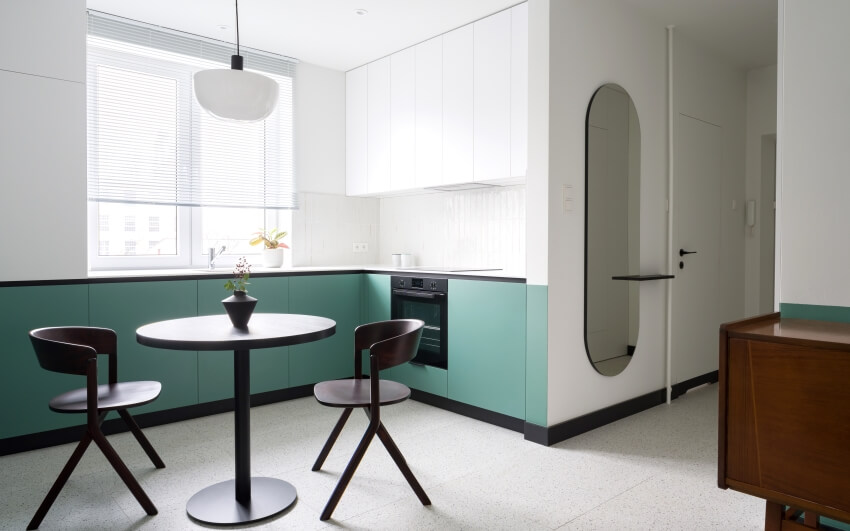
Epoxy terrazzo can be laid in thicknesses ranging from 3/8 (0.375) to 1/4 (0.25) inches. However, a minimum depth of 2.5 inches, including the setting bed, would be required for cement terrazzo.
What Is Honed Terrazzo?
The word “honed” refers to the finish of the terrazzo. A honed terrazzo finish has an anti-slip surface that is achieved when the terrazzo floor is polished to a honed or refined quality on-site.
Honed terrazzo is long-lasting, slip-resistant, and solid, making it ideal for both residential and commercial uses. It is typically composed of 70% or more recyclable materials. Furthermore, it has a dull or satin finish.
What is Terrazzo Form?
Terrazzo forms are a type of tile made by Ann Sacks that was designed to reinvent the traditional material. It used a proprietary blend of 28% recycled materials that combine with marble to create a tile that’s suitable for use indoors and outdoors.
How To Polish Terrazzo
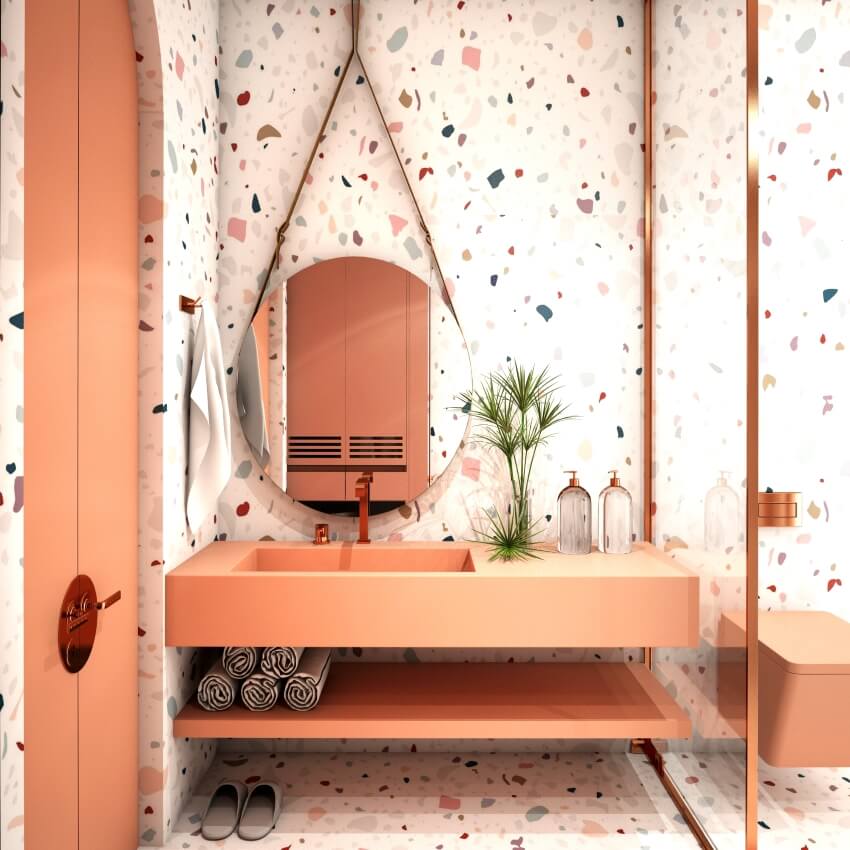
Rinse the Floors Down – After the dust has been removed from the floor, dip a soft spongy mop into a pail of warm water. Before laying it onto the floor, squeeze out any extra water.
It is not suggested to use detergent or vinegar on the terrazzo floor. Detergent can leave residues, and the acidity in vinegar can leave markings on the flooring.
Clean Up the Mess Properly Using a Mop – Start cleaning the ground in vertical movements with the sponge mop; horizontal movements tend to produce more mop markings.
To dislodge grime and dirt, wet the mop and go across the floor several times. After each set of mopping strokes, squeeze out the mop.

Start Polishing – If there is a lot of foot traffic, sealing and polishing the terrazzo floor could be required, especially if it begins to look dull. There are particular products obtainable at home construction stores for polishing the terrazzo surface as well as protecting the polish once it has been placed.
Read the Instructions and Make Sure to Follow Them – Before putting the store-bought polish and sealant, make sure to read the manufacturer’s instructions.
The majority of polishes are applied and spread using a mop before being polished with a buffing machine or by hand with towels.
You can either perform the diamond polishing method, recrystallization method, or buffing with a polishing powder method.
How To Clean Terrazzo
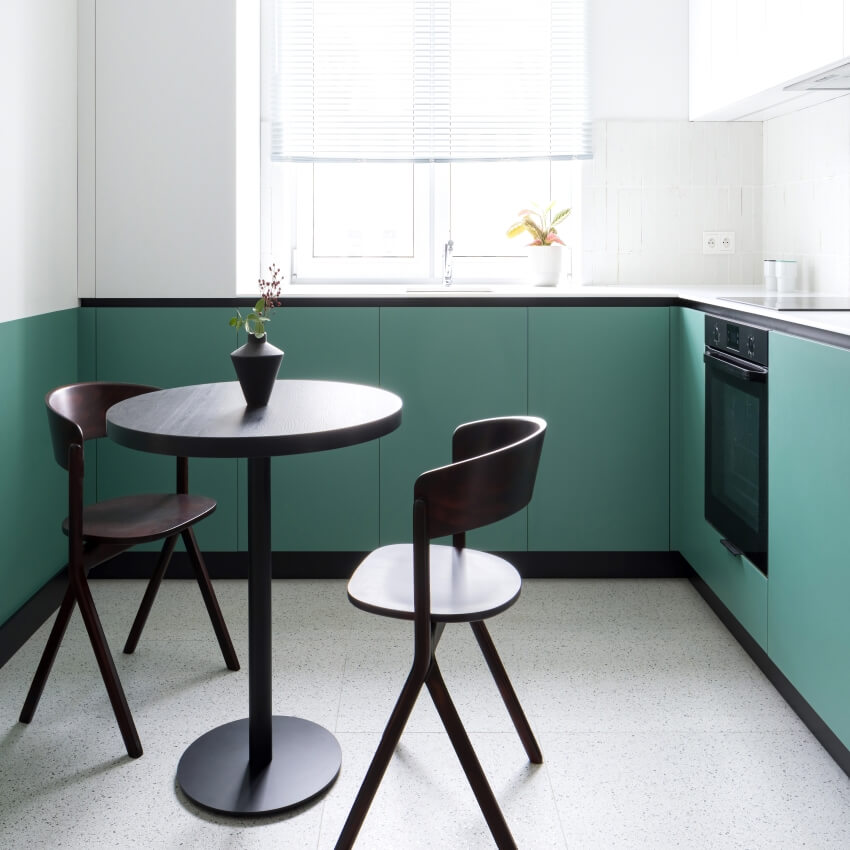
Neutral cleaners are intended to react only in solutions with clean water when combined according to the manufacturer’s directions and left on the floor surface for many minutes. This allows enough time for the grime-dissolving activity to take effect.
Afterward, using a squeegee, vacuum, or mop, remove the dirt-laden solution from the surface. Rinse thoroughly with clean water. It is critical to keep the ground wet during the cleaning procedure so that the filth and cleaning residual do not settle on the surface.
Daily Floor Cleaning Routine – Use a dust mop to sweep the terrazzo floor daily. Manually clean certain areas with a neutral cleaner diluted in warm water to eliminate tough stains and scuff marks.
Weekly Floor Cleaning Routine – Apply a neutral solution to damp-mop a terrazzo floor with mild stains once a week. Heavily filthy floors must be cleaned with motorized buffing equipment and a neutral cleaner.
Before the floor gets dry, you should start moping out any residues with water. Let the terrazzo floor become fully dry before you start buffing it with a dry brush.
Do you have any experience using these terrazzo flooring types in your home or patio? Share your thoughts regarding terrazzo tiles in the comment section. Visit our guide on the types of flooring materials for interior design for more related content.


